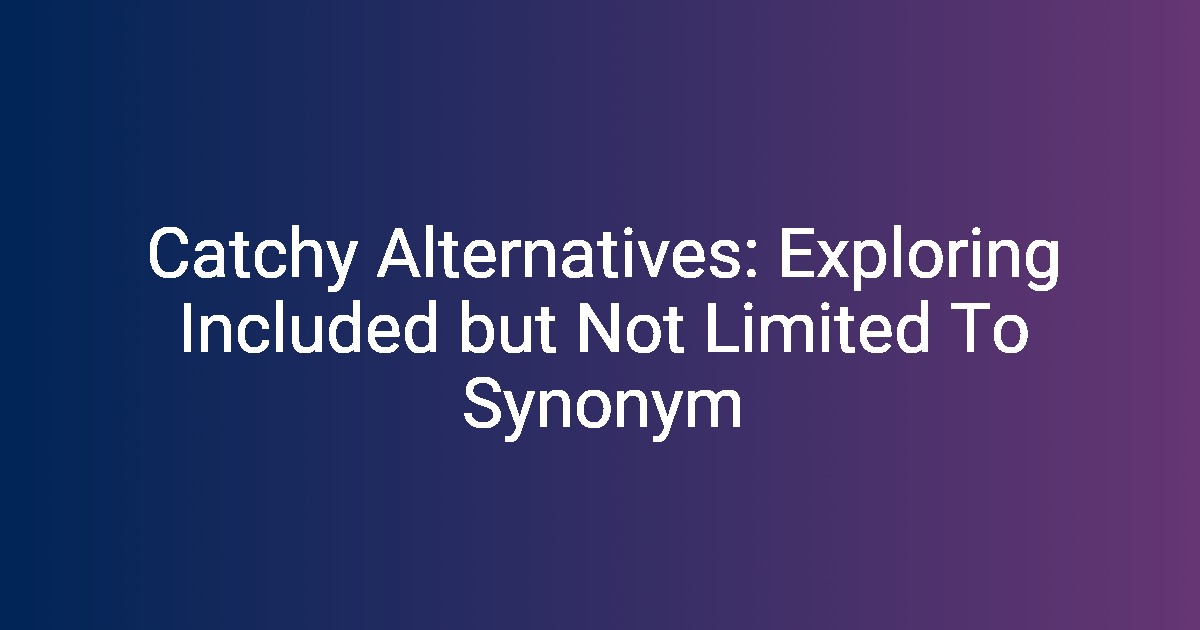The phrase “included but not limited to” is a staple in clear and precise communication. It serves as a bridge in conveying ideas, ensuring that the audience understands the possibilities without feeling confined to a strict list. The importance of synonyms cannot be overstated, as they enhance our ability to express ideas clearly and effectively. This article will delve into the phrase “included but not limited to”, explore its various synonyms, discuss appropriate contexts for its use, and provide tips on avoiding ambiguity in communication.
Understanding “Included but Not Limited To”
Definition and Usage
The phrase “included but not limited to” signifies that while a certain list or examples are provided, other items may also be present. It widens the scope of discussion and avoids constraints, making it particularly useful in formal writing. Common contexts for this phrase include legal documents, academic endeavors, and business communications. For example, a legal contract might state, “The services provided include, but are not limited to, consulting, training, and support.”
Importance of Clarity in Language
Clarity is crucial for effective communication, particularly in domains like law, business, and academia. Using phrases such as “included but not limited to” mitigates misunderstandings, making the intended message clearer. For instance, in a technical document, it’s essential to specify that listed components are not exhaustive to ensure all relevant parties have a complete understanding.
Synonyms for “Included but Not Limited To”
Direct Synonyms
Understanding the alternatives is vital for rich communication. Here are some direct synonyms for “included but not limited to”:
- Including
- Among others
- Such as
- But not only
Contextual Synonyms
The context significantly influences synonym selection. Here are some synonyms based on different scenarios:
- Formal contexts (e.g., legal documents)
- Comprising
- Constituting
- Informal contexts (e.g., conversation)
- Like
- For example
When to Use “Included but Not Limited To”
Scenarios for Usage
The phrase “included but not limited to” finds its way into several critical scenarios:
- Legal documents and contracts: It emphasizes the extensiveness of terms.
- Academic writing and research papers: It helps in illustrating broader implications of findings.
- Business proposals and presentations: It conveys a clear message regarding possible outcomes and avenues.
Alternatives for Different Contexts
Choosing the right synonym is essential depending on the audience’s familiarity with specific terms. For instance, in a legal document, saying “comprising” may convey a stronger sense of completeness than “including.” Below are examples of effective rephrasing with synonyms:
| **Original Phrase** | **Rephrased Alternatives** |
|—————————————–|—————————————————|
| “The committee included, but was not limited to, experts from various fields.” | “The committee comprised experts from various fields.” |
| “This report covers, including but not limited to, financial and social impacts.” | “This report covers various impacts, such as financial and social.” |
Differences Between Similar Phrases
Distinction from “Including Only”
The phrase “including only” serves a specific role by signaling that the items listed are the sole components, which significantly narrows the discussion. This can lead to misunderstandings, especially when the intent is to suggest a broader view. For instance, saying “The services provided are including only consulting” restricts the interpretation to just consulting services.
Contrast with “A Few Examples Are”
When using the phrase “a few examples are,” clarity may also be compromised, as it implies there are other items not mentioned, yet it does not capture the openness intended by “included but not limited to.” An example might read, “A few examples are marketing and design,” while ideally, the writer wants to convey that many more services exist.
Tips for Using Synonyms Effectively
Consider Your Audience
Tailoring language to the audience can greatly enhance understanding. When selecting synonyms, consider how familiar the readership might be with certain phrases. Employing “included but not limited to” in corporate presentations may resonate differently with executives than with a general audience.
Avoiding Ambiguity
Strive for clarity over complexity in communication. Ambiguous phrases can lead to confusion and misinterpretation, which can be detrimental in critical discussions. For example, instead of saying, “There are multiple factors affecting the outcome,” specifying the factors with “included but not limited to” provides a clearer picture: “Factors affecting the outcome include, but are not limited to, pricing, competition, and seasonality.”
Conclusion
In this examination of “included but not limited to synonym”, we’ve navigated its definition, usage, and the vital role synonyms play in effective communication. By understanding and utilizing the various forms and alternatives creatively, readers can enhance their writing and increase clarity. As a call to action, practice incorporating these phrases and synonyms into your writing, improving both communication skills and engagement.
Additional Resources
To further explore the intricacies of synonyms and effective language use, consider delving into these resources:
– [Thesaurus.com](https://www.thesaurus.com)
– “The Elements of Style” by Strunk and White for a deeper understanding of language and clarity.
FAQs
- When is it appropriate to use this phrase? Use “included but not limited to” in formal and informal settings where examples are provided, but other possibilities exist.
- What are other common phrases with similar meanings? Other phrases include “such as,” “including,” and “among others.”
- How can I improve my use of synonyms in writing? Regular practice, consulting resources like thesauruses or language apps, and understanding context can dramatically enhance your writing.
- Can I use “but not limited to” alone? While “but not limited to” can be used, it often feels incomplete and is best paired with examples.
- How does the phrase differ in informal writing? In informal writing, simpler alternatives like “like” or “for example” may be more relatable.
- Is it necessary to use formal terminology in all contexts? No, the choice of language should match the context and audience to ensure effective communication.
